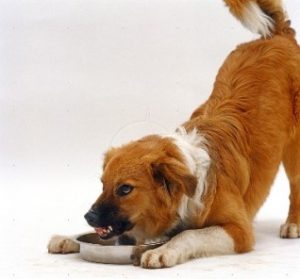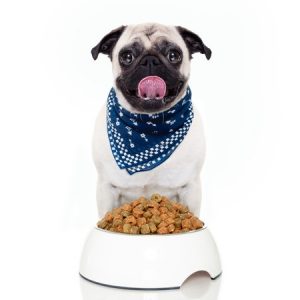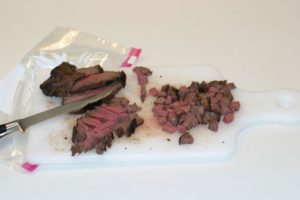Hi Meira,
I’m writing for some help with our dog Lucky. She’s a very sweet lab cross that we adopted about 7 years ago, and is very sweet. She is a very good dog, and usually very good natured. Except around her food bowl. When she’s eating, she gets very upset if my husband or I walk near her. She even growls at us. I’d like to think that we are good pet parents, and that we’re good to Lucky. We never hit her, or use harsh methods with her. We’ve tried speaking nicely and softly to her, we’ve tried ignoring her, we even leave her bowl full so there’s always some there, but she still growls when we come near her in the kitchen. We’re at a loss as to what to do. Is there any advice that you could give us? We’d really appreciate it.
Thank you,
Amy
Hi Amy!
Thanks for writing in. It sounds like Lucky is a wonderful dog, but is resource guarding her food, what some people might also call Food Aggression. I’m glad to hear that she hasn’t been punished for growling or guarding her food, and I’m assuming that she hasn’t bitten anybody and just growls when someone comes close to her while she’s eating.
I need to first advise you that it would be best to call in a qualified professional to help you with Lucky’s resource guarding issues. I can definitely give you some general advice, but resource guarding is a serious issue, and without an evaluation, I cannot give you an adequate modification plan. I can though, definitely help you better understand resource guarding, and what you can do to not make it any worse than it already is.
A lot of people think that resource guarding is a bad thing. But if you look at it from a biological perspective, it makes sense that dogs guard their food from others who may want it. If a dog who lived on the streets didn’t guard his food, he may not get enough, and that would impair him. So in that sense, it’s a normal behavior. That doesn’t mean that we should accept this behavior in our dogs who live with us. Resource guarding should be modified, as with any aggressive behavior, things could get dangerous.

Dogs can resource guard anything they consider high value. It’s not always just their food. Some dogs guard their toys, their beds, their chew items, their owners and even their personal space. And it’s the dog who defines the value of the item it’s guarding. I’ve seen dogs who resource guard Kleenex they’ve taken out of the bathroom waste bin, as well as some who guard pens and pencils from the kids’ bedrooms, as well as tee shirts and socks of family members.
We should remember that behavior is driven by emotion, and as with most types of aggression, resource guarding is rooted in fear. The dog fears that whatever he has will be taken away from him, and/or the dog feels threatened that it will be taken from him. The threat doesn’t have to be implied for the dog to fear it. This is important to remember. This is why just walking by a dog’s food bowl may elicit an aggressive response, even though no one has made an attempt to take the food away from the dog.
It’s also important to recognize the body language of a dog who resource guards. Many dogs who RG will start gulping their food faster if someone approaches. They may also hunker down over their food bowl, with their front paws beside the bowl, as opposed to beside it. Some dogs will growl while they’re eating, while others may stop eating to give a warning growl. Some dogs give a hard stare while growling, while some show the whites of their eyes (often called Whale Eye). It’s important to get a professional to help you learn and understand your dog’s body language as well.
What’s important when modifying resource guarding is to change the dog’s initial emotion that drives his behavior. So instead of being scared or threatened by people who come near their food bowl, we work on teaching the dog that someone coming near their bowl means good things happen instead of bad things. We do this by counter conditioning the dog to the trigger, which is us, as well as our proximity to the food bowl. What will help the dog change his emotion to a positive one is an amazing association with the trigger. In this case, we’d use a high value food item, something that is of higher value than what the dog already has in his bowl.

We want to change the dog’s perception of us nearing his food bowl from “uh oh, they might try to steal my food, I better guard it” to “Oh! Person coming near my food bowl means that they’ll give me even yummier things to eat!” And we’re only able to achieve this if we do this every time we are near the food bowl. Doing it once or twice is not enough. We need to do it until the dog gets excited at the prospect of us nearing his food bowl. Fear based behaviors take time to change to an effective CER (conditioned emotional response).
So we get high value food items such as cubes of cheese, or steak, or sliced hot dog, or cooked chicken, and toss it into, or as close as possible to the dog’s food bowl whenever we walk by. The goal isn’t to lure the dog away from his food bowl though. It’s to change his perception of us nearing his food bowl. That’s basically it in a nutshell, but this is where it’s important to get a qualified professional to help you. The dog’s level of guarding, as well as the dog’s threshold needs to be determined as well as respected for counter conditioning to work properly.

One thing I would definitely suggest with Lucky is to change her food bowl from being full all the time, to scheduled meal times with a measured amount of food though. This will really help cut down on her feeling the need to protect her bowl more often, which keeps her guarding behavior at higher peaks more often than if she was fed only twice a day. I recommend this to all of my clients, even for dogs who don’t resource guard. Free feeding, unless medically necessary, is not something I advise.
You can definitely start with these tips, but again, I urge you to get some help from a qualified professional who can help set up an appropriate behavior modification plan. With the proper help you’ll definitely be able to modify Lucky’s behavior and help her become a happier, less fearful dog around her food. I would really love it if you could keep me posted as well.
Good luck and happy training!
Meira
 Montreal Dog Blog Montreal's Online Dog Park
Montreal Dog Blog Montreal's Online Dog Park



